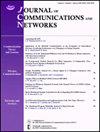利用深度学习设计无线能量转移全双工物联网网络中的短数据包通信
IF 3.2
3区 计算机科学
Q2 COMPUTER SCIENCE, INFORMATION SYSTEMS
引用次数: 0
摘要
在本文中,我们研究了无线能量传输全双工(FD)物联网(IoT)网络,其中部署了多个 FD 物联网中继器,以协助自动化工厂中具有多个天线的源和机器人目的地之间的短数据包通信。考虑到 FD 中继的两种残余干扰(RSI)模型,我们提出了一种全中继选择(FRS)方案,以最大化数据包传输的 e2e 信噪比。我们推导出了所考虑系统的平均块误码率(BLER)和吞吐量的闭式表达式,并在此基础上进行了近似分析。针对实时配置,我们设计了一个基于 FRS 方案的深度学习框架,通过一个简短的推理过程来准确预测平均 BLER 和系统吞吐量。仿真结果表明,RSI 模型对 FD 物联网网络的性能有显著影响。此外,在传统 CNN 和深度神经网络等其他方案中,CNN 设计实现了最低的均方根误差。此外,DL 框架可以估算出与 FRS 方案相似的 BLER 和吞吐量值,但复杂性和执行时间大大降低,显示了 DL 设计在处理异构物联网网络复杂场景方面的潜力。本文章由计算机程序翻译,如有差异,请以英文原文为准。
Short-packet communications in wireless energy transfer full-duplex IoT networks with deep learning design
In this paper, we study wireless energy transfer full-duplex (FD) Internet-of-things (IoT) networks, where multiple FD IoT relays are deployed to assist short-packet communications between a source and a robot destination with multiple antennas in automation factories. Considering two residual interference (RSI) models for FD relays, we propose a full relay selection (FRS) scheme to maximize the e2e signal-to-noise ratio of packet transmissions. We derive the closed-form expressions for the average block error rate (BLER) and throughput of the considered system, based on which the approximation analysis is also carried out. Towards real-time configurations, we design a deep learning framework based on the FRS scheme to accurately predict the average BLER and system throughput via a short inference process. Simulation results reveal the significant effects of RSI models on the performance of FD IoT networks. Furthermore, the CNN design achieves the lowest root-mean-squared error among other schemes such as the conventional CNN and deep neural network. Furthermore, the DL framework can estimate similar BLER and throughput values as the FRS scheme, but with significantly reduced complexity and execution time, showing the potential of DL design in dealing with complex scenarios of heterogeneous IoT networks.
求助全文
通过发布文献求助,成功后即可免费获取论文全文。
去求助
来源期刊
CiteScore
6.60
自引率
5.60%
发文量
66
审稿时长
14.4 months
期刊介绍:
The JOURNAL OF COMMUNICATIONS AND NETWORKS is published six times per year, and is committed to publishing high-quality papers that advance the state-of-the-art and practical applications of communications and information networks. Theoretical research contributions presenting new techniques, concepts, or analyses, applied contributions reporting on experiences and experiments, and tutorial expositions of permanent reference value are welcome. The subjects covered by this journal include all topics in communication theory and techniques, communication systems, and information networks. COMMUNICATION THEORY AND SYSTEMS WIRELESS COMMUNICATIONS NETWORKS AND SERVICES.

 求助内容:
求助内容: 应助结果提醒方式:
应助结果提醒方式:


